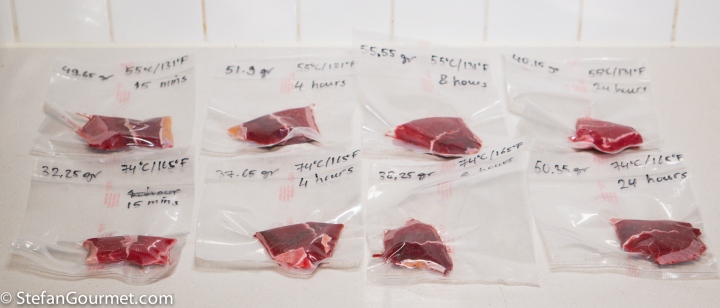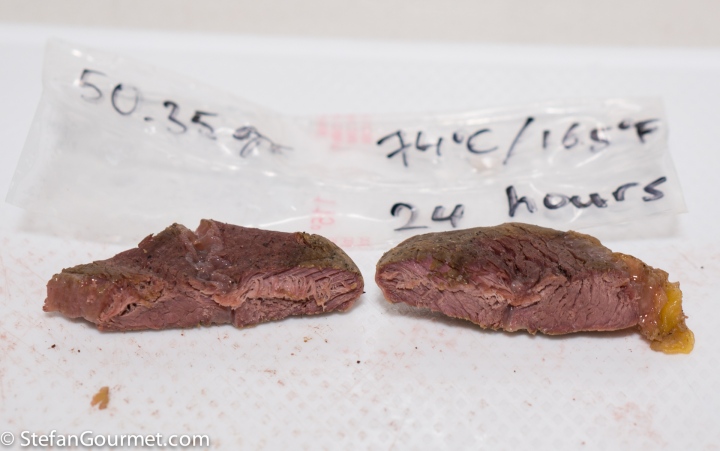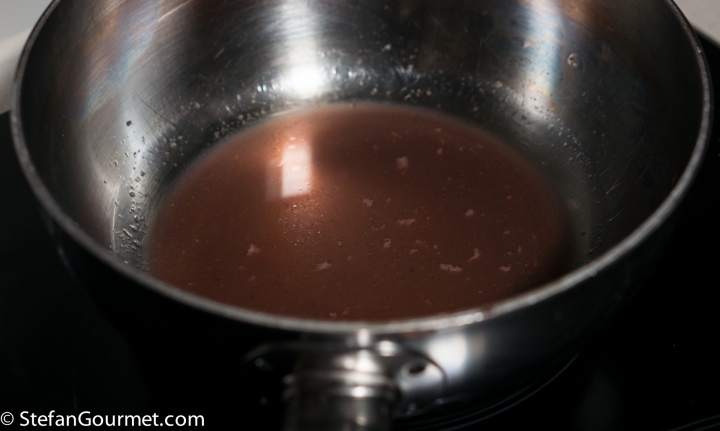Blade steaks are a cut of beef from the shoulder area with a fascia (tough connective tissue) in the center. If the same part is sliced the other way and the fascia is removed, it is called a flat iron steak. This meat is relatively tender and very flavorful because of the marbling (intramuscular fat). Blade steaks from grain-fed cattle are so tender that they can be cooked like a steak; blade steaks from grass-fed cattle are a bit less tender so I personally prefer to cook them sous-vide for 8 hours at 55C/131F to tenderize them first. In the Netherlands, blade steaks are known as sukadelappen and they are braised. The tough fascia in the center then becomes very creamy and flavorful, and that is what the “sukade” in the name refers to.
A while ago I wrote a series of articles about how cooking affects the juiciness and tenderness of meat. I knew that a blade steak can be cooked as a juicy steak by cooking it sous-vide for 8 hours at 55C/131F or as a braise (flaky) by cooking it for 24 hours at 74C/165F, but I didn’t completely understand why at the higher temperature more time was needed to end up with a tender result. And so I decided to do a series of experiments with some blade steak at different times and temperatures.
This photo shows all of the combinations I tried: for 15 minutes, 4 hours, 8 hours, and 24 hours, at both 55C/131F and 74C/165F. Since the blade steaks I used were only about 1 cm (1/2 inch) thick, 15 minutes is enough to take the core temperature of the steak within 1 degree of the water. All pieces were seasoned with salt and pepper before vacuum sealing, and weighed accurately. The loss of weight after cooking is an indication of how much water/juices are lost by the cooking process, although (especially at 74C/165F) the juices in the bag will also contain some fat that has rendered from the meat. For a fair comparison I did not sear the steak after cooking, but tried it straight out of the sous-vide. (I did pat all pieces dry with paper towels for an accurate measurement of the weight loss.)
Results at 55C/131F
After 15 minutes at 55C/131F the steak was still a bit tough but certainly edible and tasted like medium rare steak. The connective tissue was very tough and not really edible, as it would take a much longer time than 15 minutes at 55C/131F to dissolve the collagen into gelatin. I was so hungry when I was doing this, that I had already eaten the meat before realizing I should have weighed it first.
After 4 hours at 55C/131F the steak was slightly less red, but otherwise very similar to 15 minutes. The difference in tenderness was ‘too close to call’. At 55C/131F tenderization does occur, but at a very very slow pace. The weight loss was about 12%. The connective tissue was very tough and not really edible.
After 8 hours at 55C/131F the steak was again slightly less red, and slightly more tender than after 15 minutes or 4 hours. The weight loss was about 14%, but the difference in juiciness while tasting was ‘too close to call’. The connective tissue still very tough and not really edible.
After 24 hours at 55C/131F the steak was again slightly less red, but the tenderness was very similar to after 8 hours. The weight loss was about 18%. The connective tissue is still very tough and not really edible. I had expected a bigger difference with 8 hours, but the tenderization at this temperature is really very slow. The additional 16 hours are not worth it, so for cooking blade steak like steak, I will stick to 8 hours at 55C/131F.
Results at 74C/165F
After 15 minutes at 74C/165F, the weight loss is already 26%, so that is a lot more than after even 24 hours at 55C/131F. As explained in this article, this is because above 57C/135F the collagen shrinks and squeezes water out of the meat. But more so than the dryness of the meat, what struck me when biting into this was how tough it was compared to the blade steak samples at 55C/131F, and especially the sample after the same 15 minutes at that temperature. As connective tissue is broken down more quickly at 74C/165F than at 55C/131F you may expect the meat to be more tender at the higher temperature. However, the fact that the high temperature instantly contracts the meat (just like meat will shrink when you put it in a hot pan) has a bigger toughening effect than what can be compensated for by the higher temperature in such a short time of only 15 minutes. Also the fascia inside is still very tough in this sample. It is also visible that the meat has less color, this is because myoglobin (that gives meat its red color) breaks down more quickly above 60C/140F.
After 4 hours at 74C/165F, even more of the red color is gone and the loss of weight is now 36%. The meat is tender, but dry. The fascia is edible and tender enough, but not at all ‘creamy’ like when it is braised traditionally.
After 8 hours at 74C/165F, it is a bit more tender and has a bit less color, and it seems less dry even though the loss of weight is also 36%.
After 24 hours at 74C/165F, the meat is fall apart tender. You can now cut it with a spoon, and the fascia has its creamy quality.
In this photo it is clear how easy it is to tear it apart. The weight loss is 38% and thus a bit higher, but when tasting it, the meat seems a lot less dry than after 4 or 8 hours.
The best way to serve this meat is to pull it with two forks and to mix it with the juices from the bag. The juices will coat the flakes of meat, so it will not only be very tender, but also very succulent.
Effect of temperature on the bag juices
All cooks except 15 minutes at 55C/131F involve a significant loss of meat juices that end up in the bag. These are flavorful juices, so it is worth making a sauce out of them.
The juices of the blade steak cooked at 55C/131F have a reddish color, and when you bring them to a boil…
…the proteins in it will coagulate. This happens because the proteins have only been heated to 55C/131F, and so heating them higher will make them coagulate. There are three ways to use the bag juices to make a sauce anyway:
- Mix in a slurry of cold water and cornstarch (or another starch-based thickening agent) before bringing to a boil. This will lead to a flavorful sauce, but the color is not so nice.
- Sieve out the coagulated proteins using kitchen paper. This will lead to a clear stock, but it won’t have as much flavor because a lot of flavor has been filtered out.
- Some additional ingredients in the bag will prevent this from happening, like some marinades. I haven’t figured out exactly yet why, but it works with teriyaki for instance.
The juices from the meat cooked sous-vide at 74C/165F can be brought to a boil without any coagulation occurring. For a great result, pull the beef into flakes with two forks after cooking 24 hours at 74C/165F, bring the juices to a boil and then turn off the heat, then mix the pulled beef with the juices. (Depending on the amount of juices, you could allow them to reduce a little before turning off the heat.)
Conclusions
So what can we learn from this experiment?
- Tenderization at 55C/131F happens, but it is so slow that even 24 hours of cooking have only a small effect.
- Loss of juices is determined first and foremost by temperature, but also by time. The biggest loss of juices occurs in the beginning of the cooking process when the meat is brought to the cooking temperature all the way through through contraction and thus squeezing out juices. The higher the temperature, the stronger this effect. A slow loss of juices continues after the initial fast loss of juices.
- At 74C/165F the toughening effect of contracting connective tissue is at first much stronger than the tenderizing effect of breaking down connective tissue. It takes many hours for the tenderizing effect to catch up and in the end ‘win’.
- Recommended time/temperature combinations for grass-fed blade steak (or flat iron steak) are 8 hours at 55C/131F for ‘steak like’ or 24 hours at 74C/165F for ‘braised’. The latter can be improved even further by ‘pulling’ the beef and mixing the pulled beef with the juices from the bag.
If you go higher than 74C/165F, the initial toughening and drying effect will be even stronger, but the tenderizing effect afterwards will be quicker. This is why a traditional braise will give you a result in less time (usually 3 to 4 hours instead of 24 hours) that can be as tender, but will be drier than at 74C/165F. I will do some further experiments to look into this a bit more.
Read my previous articles about juiciness and tenderness to understand the mechanisms behind this experiment and its conclusions.

















*smile* No wonder you are so successful at your daytime job ! Do hope your systematic research will help more than one reader ! Shall file ‘in case’ ! Every country cuts meat differently . . . your first photo is what we in Australia call
‘scotch fillet’ . . . much cheaper than the ‘real stuff’ but almost as tender and with much more flavour than the ‘real thing’ . . .
LikeLiked by 1 person
The “scotch fillet” I saw in Australia was ribeye, a different cut from this one. Indeed cheaper than tenderloin, but more expensive than blade steak. According to Wikipedia, this cut is called “oyster blade steak” in Australia.
LikeLiked by 1 person
Stefan: You have put me to shame, truly! Of course you are right! . . . . you would not credit I regularly do buy ‘oyster blade’ . . . . sheesh, teach 🙂 !!
LikeLiked by 1 person
Thank you for this. I’ve just tried it and it was beyond my expectations. And those blade steaks, not only they are not very popular here, I really don’t think more than 1 percent of people are even aware they can be eaten in the form of a steak. Here it is stew and soup meat, period (and to be honest I’ve bought them for a soup).
Really delicious.
LikeLiked by 1 person
So here’s my question concerning this – and its application to ribs – pork or beef: I know I need to be above 170F in order for the tenderizing to happen in a braise. Its a matter of the ideal length of time at a given temperature in this range to get that sweet spot where it is almost but not quite fall off the bone. I don’t want to gently pull bone and all the meat is left behind (i.e. pulled pork territory). It seems that somewhere between 1-2 hours is about right – but its something I need to nail down more. Have you looked at this particular aspect in your investigations?
LikeLike
You don’t need to be above 170F in a braise (meaning the temperature of the braise itself; if you mean the oven temperature then it is probably quite accurate) as 165F clearly also works. It will just take more time. If you want it in 1 or 2 hours then you will need a much higher temperature like 185F, but the meat will lose a lot more juices then. I would say that 24 hours at 165F will get you exactly where you want to be: almost but not quite fall off the bone. You could always take it down to 18 hours if you still think it falls off the bone too easily. Personally I prefer pork ribs 24 hours at 135F, that is not fall of the bone at all but more like the texture of pork tenderloin and pink (but absolutely safe to eat as it is very much pasteurized).
LikeLike
I finally got myself a vous vide machine, so now your blog is going to make a lot more sense to me!
LikeLiked by 1 person
Great! There is a lot of information on this blog. This article could be a nice start: https://stefangourmet.com/2018/04/01/how-to-choose-time-and-temperature-to-cook-meat-sous-vide/
LikeLike
A classic of the Stefan post variety. Great method giving clear results and a consistent commentary. Good to see.
LikeLiked by 1 person
tu sei troppo avanti, io davvero naif
LikeLike
Sei troppo gentile!
LikeLiked by 1 person
dico la verità
LikeLike
Sadly I don’t have a sous-vide machine so this post is presently lost on me. However, I shall bookmark it, in case I decide to get one.
LikeLiked by 1 person
You should! 🙂
LikeLike
Can a combination of temperatures help get the tenderisation of higher temp, and the juice retention of lover temps?
For example, do 2 hours at 55C and only then go to 74C for a few more hours.
I hope this way the collagen will not shrink as much, and certainly not as fast. So the squeezing action should be reduced.
But, this theoty/hope requires testing. And also the times for low and high temp should be optimised, if it works at all.
Van harte bedankt!
LikeLike
You would need at least 12 hours at 55C for this to make a difference, as the collagen will only break down at a very slow pace at that temperature. I doubt whether it is possible to get a better results that way, because I expect you need to tenderize the meat too far to make a real difference at 74C. But the result when just cooking at 74C is very good, as long as the meat has some intramuscular fat (marbling).
LikeLike
Question: if the collagen process occurs at 57 degrees or above, what happens if you aim for a steak like texture but cook for 24 hours at 57 degrees so it retains the texture but breaks down the tough sinew in the centre? Or does it overcook the steak by cooking above 55 degrees?
LikeLike
Hi Clement, the collagen process even occurs at 55 degrees, but even more slowly then at 57. At 57 even after 24 hours the tough sinew in the center will not have broken down. It will be slightly more towards medium at 57 compared to 55, but I would not consider that to be overcooked.
LikeLike